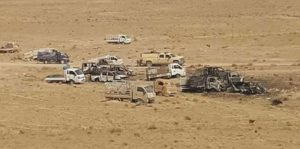by WorldTribune Staff, July 5, 2016
The U.S.-led coalition reportedly warned Iraq’s military that civilians, including children, where part of a large convoy of Islamic State of Iraq and Levant (ISIL) vehicles that were hit by airstrikes while fleeing Fallujah.
The convoy departed Fallujah on June 28. Over the next two days, most of the vehicles in the convoy were destroyed and reports say as many as 750 ISIL jihadists were killed.

The Ministry of Defense in Baghdad announced on June 30 that Iraqi attack helicopters had struck the convoy.
Later on June 30, the spokesman for the U.S.-led coalition said that coalition forces had also taken part in the air strikes — but Iraqi sources denied that claim.
Reporting for warisboring.com, journalist Arnaud DeLalande said he interviewed Iraqi military pilots “and what they told me contradicted the coalition’s official story.”
The Iraqi helicopter pilots “took the initiative” in the attack on the convoy on June 29.
“As they approached the area, they encountered heavy automatic gunfire from the ground,” the report said. “In a series of fierce attacks that lasted hours, Iraqi helicopters destroyed more than half the convoy, killing dozens of militants.”
“Photos and videos of the aftermath of this attack that have appeared on social media clearly show that the convoy consisted of a mixture of civilian and military vehicles. One video depicts a large number of M79 Osa anti-tank unguided rockets next to several vehicles.
“Still, it’s possible that some of vehicles carried militants’ families — which is apparently why the United States initially refused to take part in the operation.”
Coalition spokesman Col. Chris Garver said U.S. aircraft specifically avoided the part of the convoy the coalition suspected of carrying civilians.
“Shortly after the first convoy’s destruction, Iraqi military intelligence received reports of another Islamic State convoy — around 30 vehicles — leaving Fallujah in a northwesterly direction,” the report continued.
“Next came reports of militants — apparently survivors of the first column — killing many civilians east of Ramadi. On June 30, the Iraqi army deployed a number of Bell 407 scout helicopters and Mil Mi-28 gunships to reconnoiter the situation.
“After encountering automatic weapons fire, the Iraqi pilots began maneuvering for position, but this time the U.S. Air Force ordered all helicopters to vacate the area.”
Once the Iraqis had left the area, U.S.-coalition jets launched their own attacks.
“In the following hours, Iraqi army aviation flew dozens of medical evacuation sorties with Mi-17 and EC.635 helicopters, evacuating injured civilians from the vicinity of the coalition’s air rads, including many children,” the report said.
Later on June 30, Garver stated that the coalition had “struck two major Islamic State convoys fleeing Fallujah over the last two days.” Garver said the raids destroyed 55 trucks southwest of Fallujah and approximately 120 others — including three carrying improvised explosive devices — east of Ramadi, while Iraqi air force and army aviation destroyed dozens of additional vehicles.
“While it is clear that the U.S. armed forces and the coalition they lead are doing their best to avoid targeting civilians, it remains unclear why the Iraqis launched their first attack despite the Americans’ warnings about civilians?,” DeLalande’s report asked.
“Why did the Americans prevent the Iraqis from attacking the second convoy, but then attacked on their own? Finally, who caused the injuries to civilians on June 30. Was it ISIL, the Americans and their coalition or Iraqis?”
